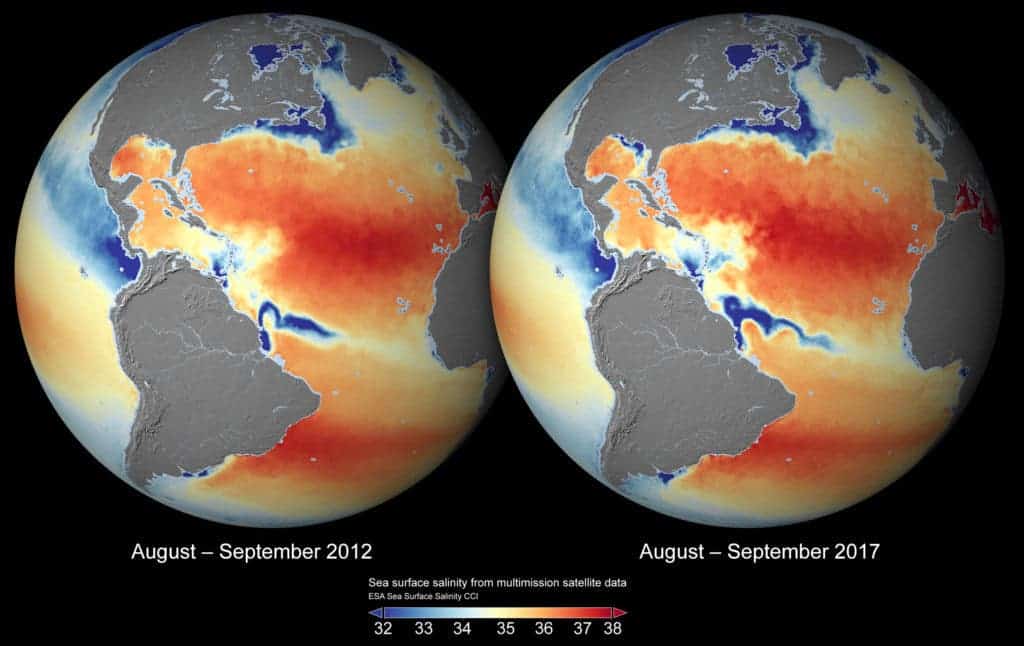New research from the European Space Agency (ESA) Climate Change Initiative is offering new insight into sea-surface salinity across the world. The data will help researchers better estimate the effects of climatic shifts on the world’s oceans.

Image credits European Space Agency.
Ocean water is salty — but these salt levels aren’t the same everywhere. This saltiness is a key variable in the Earth’s climate systems, as it’s the product of multiple different factors (additions of freshwater from rivers, rain, glaciers or ice sheets, or on the removal of water by evaporation). Understanding how salinity changes over time and distance can help us better understand (and predict) man-made climate change. Now, thanks to the ESA’s efforts, we can monitor it from space.
Salt-o-meter
“The project aims to make a significant improvement to the quality and length of the datasets available for monitoring sea-surface salinity across the globe,” says Susanne Mecklenburg, head of ESA’s Climate Office.
“We are keen to see this new dataset used and tested in a variety of applications, particularly to improve our understanding of the fundamental role that oceans have in climate.”
The ongoing project from the ESA’s Climate Change Initiative (CCI) has produced the most complete dataset of sea-surface salinity around the world to date. The CCI aims to generate accurate and long-term datasets pertaining to 21 Essential Climate Variables set out under the United Nations Framework Convention on Climate Change and the Intergovernmental Panel on Climate Change.
Sea-surface salinity maps can be used to monitor natural water cycles, evaporation rates, and ocean circulation. These processes are central elements of the climate system of today as they help transport heat, nutrients and carbon around the planet. Unusual salinity levels can also indicate that extreme climate events, such as El Niño, are about to start.
Such measurements have been taken before — they indicate that ever since the 1950s, salty areas around the world are becoming saltier, while freshwater areas are becoming fresher. However, there has always been a measure of debate over these findings, as they relied on scientific ships trawling the oceans to read salinity, which provides relatively poor accuracy (as they’re quite slow to move around). Using satellites to capture a global snapshot would give us a much better idea of what’s happening.
The team behind the project, Jacqueline Boutin of LOCEAN (Laboratory of Oceanography and Climatology) and Nicolas Reul of IFREMER (French Research Institute for the Exploitation of the Sea) pooled together data from three satellite missions to create a dataset spanning nine years, with maps generated on a weekly and monthly basis.
The team measured brightness temperature as a proxy for sea-surface salinity using microwave sensors onboard the SMOS, Aquarius, and Soil Moisture Active Passive satellite missions.
“Monitoring salinity from space helps to resolve spatial and temporal scales that are poorly sampled by in situ platforms that make direct observations, and fills gaps in the observing system,” says Dr. Boutin.
“By combining and comparing measurements between the different sensors, [we improved] the precision of maps of sea-surface salinity by roughly 30%.”
Ocean–atmosphere exchanges around the world are driven by winds and exchanges between surface and subsurface ocean water, the team explains. These later ones are powered by changes in water density, a product of both temperature and salinity (salty water is denser than freshwater). In the deep ocean, density variations are the main driver for the movement of water. Studying changes in salinity, the team explains, can thus help better model ocean-atmosphere exchanges, and the behavior of deeper ocean layers — both of which will allow us to better estimate climate shifts in the future.
The team is currently working with climate scientists to compare the new dataset with in situ observations and with the output from salinity models.
The dataset is freely available for download from the CCI Open Data Portal.






